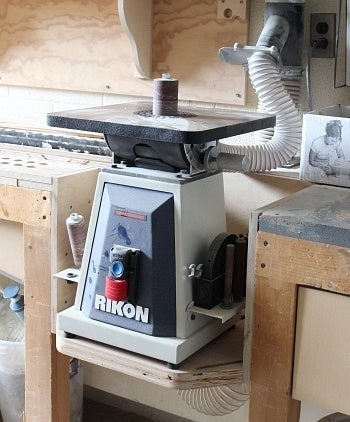Description and uses
The spindle sander is used for sanding the edge of a workpiece’s interior curved profile. It is an aggressive sander, but less so than the Belt and Disc sander in the shop. It has a steel bed for supporting the work piece. The bed can be adjusted up to 45 degrees from perpendicular. Interchangeable spindles are available in various diameters. While running, the spindle sander rotates in a clockwise direction while moving up and down to prevent consistent sanding marks.
Pre-use Inspection & Maintenance
- Make sure that the abrasive media installed on the machine is not torn or loose.
- Ensure the bed is clear of materials, tools, and debris.
- Check that all adjustment knobs and parts are fully tightened.
- The shop dust collection system should be running while the spindle sander is in use.
Operating Procedure
Never start the machine with the work piece touching the abrasive surface.
Never touch or place fingers or other body parts on or close to the spinning abrasive media when the machine is running.
Start and stop the sander with the blue “on” and red “off” buttons on the front of the machine.
Stand in a stable position and hold your materials firmly on the sander’s bed with both hands. Longer pieces may need to be supported by a work support. Push the material gently into the spindle, making certain to keep your hands away from the abrasive surface of the spindle.
The spindle spins in a clockwise direction. Attempt to feed materials from left to right when sanding (into the direction of the spinning sanding media). Ensure that materials are held firmly on the bed to prevent them from being thrown by the machine.
Tip
Sand slowly, periodically checking for measurement and alignments. Don’t overwhelm the machine by forcing materials too quickly or aggressively into the spindle.
Lock-Out Procedure
Ensure the equipment power switch is in the off position. Unplug the equipment from the electrical receptacle. Place lock-out plug cover and lock on to the end of the electrical cord.
Cautions
- Eye protection is mandatory
- Ear protection is required for prolonged use.
- A dust mask is recommended for plywoods and particleboard and required for MDF and toxic wood species that generate fine dusts.
- Never work with loose fitting gloves or hold material with a rag when sanding.
Hazards
- Toxic wood dusts, glues and resins often found in plywoods, particleboards and MDF are released when being sanded and machined. Wood dust is classified as group 1 carcinogen.
- Abrasive media that can cause severe friction burns and abrasions to body parts that accidentally contact moving parts.
- Sustained vibrations which can lead to permanent nerve and muscle damage after prolonged and repeated use.
- Excessive noise leading to cumulative hearing loss.
